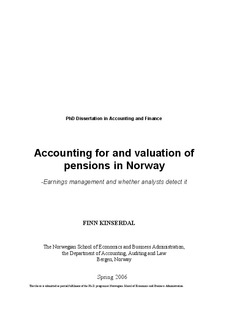| dc.description.abstract | Conclusions and summary of “Accounting for and valuation of pensions in Norway; earnings management and whether analysts detect it”
“Pension accounting is a magnificent example of all that is right and wrong with accounting” (Henriksen and van Breda 1992, p. 757).
In my research I have discussed pension accounting and how the rules relate to the IASB Frameworks, the FASB Concepts Statements, the basic accounting principles in Norway and asset pricing theories in general. I have then, by using a database I have constructed of pension information disclosed by Norwegian listed firms, tested whether there are earnings management indications re. pensions, and then finally tested whether the analysts following the firms have detected the earnings management and adjusted for it in their valuation models.
The conclusions are:
The Norwegian, IAS and USGAAP accounting rules for pensions are not in line with the Frameworks and Concepts or in line with the accounting rules treating similar situations.
However; the valuation of pension assets and pension liabilities disclosed in the notes of financial reports are close to theoretically accepted valuation models, and should fit directly into most analysts' valuation models.
Hence analysts should adjust the reported/recognised financial numbers with the information found in the notes. However; if these numbers are managed the analysts have to do their own calculations or adjustments using the disclosed information.
So I tested for earnings management in the Norwegian stock market context, and tested how the analysts treated pension information:
The assumptions used to calculate the pension liabilities are influenced by earnings management (significant at the 5 % confidence interval, twosided test, only firms with significant PBO in % of total assets where included, 40 firms in the sample): firms with low equity ratios use "optimistic" assumptions; assumptions that reduce their recognised pension obligation (to avoid an even lower equity ratio) and vice versa; there are indications that firms with high equity ratios in use "pessimistic" assumptions, harming their equity ratio somewhat- but as a result (in most cases) improve their future recognised earnings.
Did the analysts discover this and adjust for it in their valuation models?
I interviewed and checked the analysts’ spreadsheets (94 cases) for the listed firms in Norway with the most abnormal pension assumptions and where adjustments to normal assumptions would have highest impact on the firm’s equity ratio: (21 firms). In only 2 of the 94 cases the analysts had done any adjustments at all. The adjustments were done only on the firm that had been heavily focused on using abnormal pension accounting/pension assumptions in the press. Hence the answer to the question posed is clearly no.
The findings raise questions whether the stock market prices reflect all available information, since influential and skilled market participants like the analysts do not detect and adjust for important information disclosed in the financial reports when they value stocks. | |
